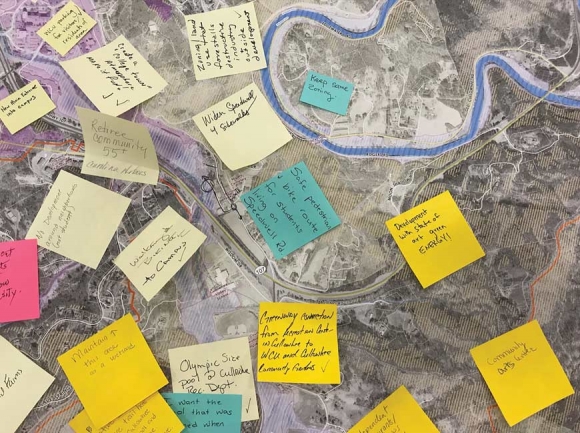Planning underway for Cullowhee’s future
 Sticky notes cover Cullowhee with suggestions from community members. Holly Kays photo
Sticky notes cover Cullowhee with suggestions from community members. Holly Kays photo
Development of a plan to guide Cullowhee’s future is now underway, with a three-day marathon of activities held April 22-24 gathering feedback from the community toward a draft small area plan for the community.
“I think it’s safe to say we touched 250 to 300 people,” said Jake Petrosky, a consultant from the Raleigh-based firm Stewart working on the project. “I’m really happy with it.”
The first two days featured the fullest schedule of public input opportunities, with residents, Western Carolina University students and university employees stopping by to share their dreams for Cullowhee on large sheets of paper hung on the walls of a room in WCU’s Ramsey Center, and on sticky notes affixed to maps and project boards. The effort also included a walking tour of old Cullowhee, which about 30 people attended.
Frequent comments included a desire for more nightlife and dining options, expanded housing opportunities for families, more bike and pedestrian pathways, more parking and protections for green space.
“One of the things that we’ll be talking about at our next meeting is just a little bit more detail on some of these recommendations,” Petrosky told the Cullowhee Planning Council, which also serves as the steering committee for the plan, during an April 23 meeting to discuss public input results. “A key piece of that is going to be a future land use map.”
A land use map can include zoning but also looks to the future, anticipating Cullowhee’s future development patterns and discussing what regulatory tools can be used to guide them.
Related Items
In discussing the results of the public input, committee members focused heavily on housing.
“Back in the old days there was a feeling of community in Cullowhee and the university because people could live here, and now that’s different,” said committee member Myrtle Shrader.
Most new housing in Cullowhee is focused on students, so university employees often find themselves driving over from Franklin or Waynesville. Mike Byers, vice chancellor for administration and finance at WCU, said that fixing the housing issue has long been a focus for the university. Ideally, WCU would like to see the private sector take care of it, but that’s proven challenging.
“It just doesn’t happen because the student housing is so much more lucrative and lower-hanging fruit,” said Byers.
Developers can build student-housing units with multiple bedrooms and rent them out for $750 per bedroom — but university employees who have families and are looking for three- and four-bedroom homes can’t afford that rate. There’s little incentive for a developer to build housing geared toward families when, for the same investment, they can build student housing that promises a much higher return.
There are various options for helping to fill the gap, said Petrosky — zoning, public-private partnerships, land trust options — but figuring it out will take time and effort.
“This is not a problem that is unique to Cullowhee,” said committee member Jack Debnam. “It’s every university across the state and probably the nation. I doubt everybody that works at N.C. State can get on a bicycle and ride to N.C. State. They live in Apex, they live in Fuquay, they live in Wake Forest if they’re lucky. We can’t cure that problem.”
In Cullowhee, there’s the added issue of limited buildable land.
“If you start netting out everything that’s built and not likely to change, and if you start netting out steep slopes and floodplains, then what you’re left with is a very small amount of buildable land that’s not already spoken for,” said Petrosky.
Revitalizing Old Cullowhee was another focus of discussion, especially in light of ongoing efforts by the organization CuRvE to establish a river park along the Tuckaseigee River where the Cullowhee Dam is now.
“They have a game plan for what they want to do in the river and immediately adjacent to the river,” said Petrosky. “What we want to do is think about how does that relate to Old Cullowhee? How does that relate to redevelopment and what could happen in Old Cullowhee?”
Old Cullowhee used to be the front door to the university, but when the four-lane N.C. 107 was built all the traffic was rerouted and the businesses languished. The river park could help by creating a new attractor for Old Cullowhee — as Petrosky said, “replacing traffic with people.”
“I’m a process person,” said Committee Chair Scott Baker. “So for those abandoned houses, for that to be a park someone is going to have to buy and demolish those and develop it. The motivation to pay to have stuff torn down doesn’t seem to be very high, so how do we get there?”
Having a plan is the first step, said Planning Director Mike Poston. With a plan in place, the county’s economic development director will be better equipped to connect with people who might be interested in making the vision a reality.
“If the regulatory framework is sufficient to create that vision, that’s one less thing he has to tell people — ‘Well, we might be able to work with you on the regulatory end.’ If it’s already worked out it’s one less hurdle in the way,” said Poston. “Then they can concentrate on site development costs.”
Stewart is now working to distill the public input down into workable items to include in the draft plan, which will be released in September, and comment is still being accepted through an online survey. At that point, it will be put out for additional public comment. After that comment is incorporated, Poston will present it to county commissioners for adoption, likely sometime in the fall.
“We had a lot of great participation in the last couple days,” said Poston. “Hopefully we’ll get that much participation when the draft plan comes out.”
Take the survey
A survey open through the end of May is seeking input on what people who live and work in Cullowhee would like to see for the area’s future. It is available at www.surveymonkey.com/r/cullowhee.
For more information about the Cullowhee Small Area Plan, visit www.planning.jacksonnc.org/cullowhee-small-area-plan.









